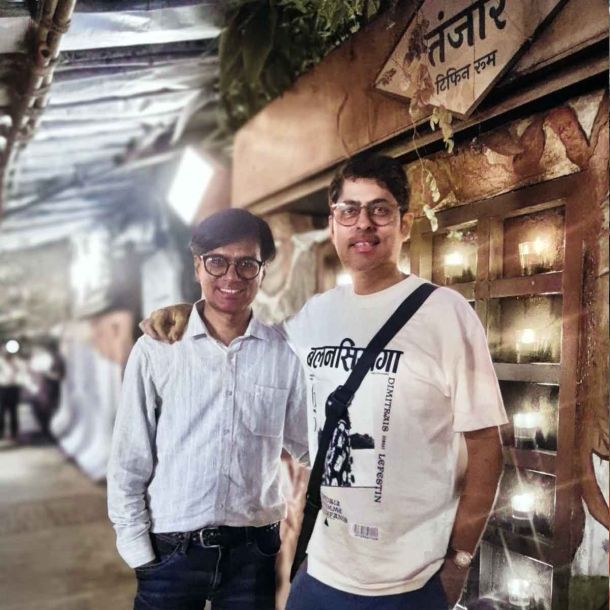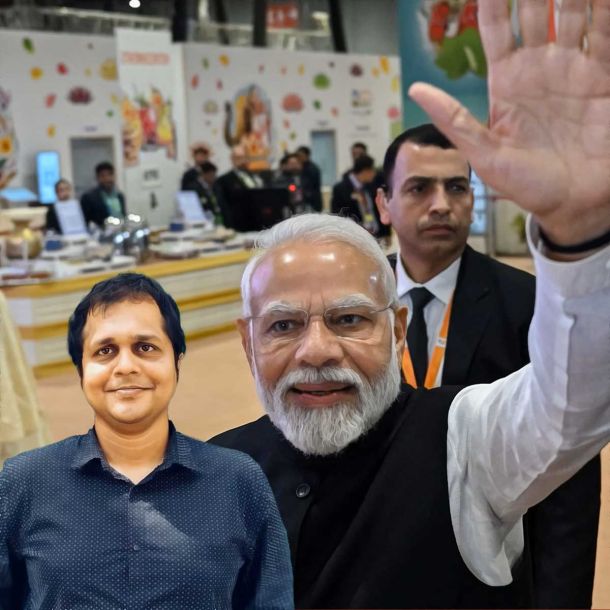More Coverage
Twitter Coverage
Satyaagrah
Written on
Satyaagrah
Written on
Satyaagrah
Written on
Satyaagrah
Written on
Satyaagrah
Written on
JOIN SATYAAGRAH SOCIAL MEDIA
'Whats Wrong With India': A trend intended to malign India globally, backfires as Indians, showcasing unity, resilience & humor through a viral Israeli embassy video and national achievements, flipped the narrative, highlighting India's indomitable spirit

Have you noticed the phrase "What's wrong with India" popping up all over X lately? It's not just you—this question has rapidly climbed the ranks to become one of the hottest topics on the platform. Users are buzzing, creating and sharing posts that delve into this very inquiry.
|
As you scroll through X, it's hard to miss the satirical edge many of these posts carry. The phrase "What's wrong with India" has been echoing through the digital halls since 13-14 days, capturing the curiosity and creativity of netizens far and wide. Each post, unique in its content, comes together to form a tapestry of perspectives under this trending tag.
If one were to depict the rollercoaster journey that the 'What’s Wrong With India' trend has embarked on over the past 10 to 13 days, it would be perfectly illustrated by Michael Gary Scott's iconic "how the turntables" moment from the beloved sitcom 'The Office'. Confused about this sudden pivot? Let's dive deeper into the details. Initially, the 'What’s Wrong With India' trend began spreading like wildfire across social media, especially on X (formerly known as Twitter). The prevailing sentiment was that the trend aimed to cast India in a negative light, with the majority of participants being non-Indians. Yet, in an impressive display of digital prowess, the narrative experienced a dramatic shift today, thanks to the proactive engagement of Indian users. Wondering how they managed this feat? Stay tuned for an in-depth look. However, before we unravel this tale, it's crucial to understand the genesis and essence of this trending topic.
Interestingly, the movement has gained such momentum that even the official MyGovIndia account has thrown its hat into the ring, participating in the trend. But what exactly is fueling this widespread engagement? Let's explore the origins, the evolution, and the current state of the 'What's Wrong With India' trend, as it continues to unfold on the virtual stage of X.
|
Understanding the 'What's Wrong With India' Trend
At its core, the 'What's Wrong With India' trend was exactly what it sounded like. Individuals from around the globe began sharing content that spotlighted Indian stereotypes, all tagged under 'What’s Wrong With India'. This wasn't just a trickle of posts but a deluge that saw lakhs of users bringing to light various videos and images. The content ranged widely but shared a common theme: it cast India in a less-than-flattering light, touching on issues such as public hygiene, poverty, criminal activities, and more. This trend didn't just catch on; it exploded in popularity, with many attributing its rapid spread to the powerful algorithms of X (formerly Twitter), which seemed to amplify these disparaging views.
The virality of such content was staggering. Within days, posts from foreigners leveraging the 'What's wrong with India' tagline surged across the platform. These weren't mere observations; they were potent critiques packaged in videos and pictures, each amplifying stereotypes or pointing out real societal challenges within India. The unusual surge in traction these posts received sparked a debate among netizens, with a significant number pointing fingers at X's algorithm for propelling this narrative into the spotlight.
But why this sudden spotlight on India's flaws? The question loomed large as the trend continued to gain momentum, drawing in lakhs of participants. Each shared piece of content seemed to fuel the fire, increasing the number of posts that, intentionally or not, tarnished India's image on the global stage. The trend's escalation prompted introspection and speculation alike about the motivations behind this digital onslaught and the reasons it resonated so strongly across the X platform.
|
The Spark Behind the 'What's Wrong With India' Trend
The origin of the 'What's Wrong With India' trend can be traced back to a distressing event that occurred a few days ago. A Spanish woman, while traveling in Jharkhand’s Dumka district with her husband, became the victim of a gang-rape by seven men. The incident, which took place on March 01, shocked the nation and the international community alike. In the aftermath, police action was swift, with four of the accused reportedly arrested, and efforts ongoing to apprehend the remaining perpetrators. This horrifying event served as the catalyst for the trend, as people began to voice their grievances and share their negative experiences related to India, giving momentum to the conversation on social media.
The attack not only caused widespread anger but also led to a global discussion about the safety and image of India as a travel destination. Many users, leveraging the 'What's wrong with India' hashtag, shared their adverse travel experiences, while others expanded the narrative to critique broader societal issues within the country. The conversation quickly escalated, with some commentators branding India as the “rape capital of the world” and criticizing aspects of its hygiene and cultural practices. These posts, characterized by their negative portrayal of India, gained significant attention and were accused of contributing to a tarnished image of the country on the international stage.
Critics of the trend pointed out the unusual traction these posts were receiving, suggesting that there was an anti-India agenda at play, amplified by what they perceived as a "biased algorithm" on X (formerly known as Twitter). This algorithm, according to some users, favored content that painted India and Indians in a negative light, thereby fueling the trend's growth and reach.
As days passed, the trend evolved further, taking a darker turn. Beyond sharing personal experiences and criticisms related to the initial incident, the conversation expanded to include a wide array of Indian stereotypes and other derogatory content. This shift moved the focus away from the serious crime that had triggered the trend, broadening the scope of the discourse to encompass a range of topics that were often unrelated to the actual event. This transformation of the trend highlighted the complex dynamics of social media movements, where initial incidents can spark broader, and sometimes unrelated, discussions that significantly impact public perception.
|
Indians Come to the Rescue!
As the narrative around the 'What's Wrong With India' trend continued to evolve, it took yet another unexpected turn, this time with Indians stepping up to reshape the conversation. The focus of the trend had drifted significantly from its initial catalyst, the tragic incident in Jharkhand, to a broader critique filled with memes and posts on X (formerly known as Twitter) that were largely unrelated to the core issue. Observing this shift, Indian users decided it was time to 'fight back' and redirect the narrative once more.
Indians made a strategic move on X, ingeniously using the very hashtag that had been turned against them, ‘What’s Wrong With India’. However, their approach was different; they began sharing content that depicted questionable public behaviors from around the globe, specifically from Western or developed nations. The twist was in maintaining the original hashtag, thereby challenging viewers to question the fairness of the critique leveled solely against India. The underlying aim was twofold: to expose the alleged bias in X’s algorithm, which seemed to favor anti-India content, and to counteract the negative portrayal of India with a mirror to the world, implying that such issues were not unique to India alone.
The counter-movement gained traction quickly, with many social media users embracing this approach by posting sarcastic and thought-provoking tweets using the same contentious phrase. These posts cleverly highlighted similar societal issues prevalent in other parts of the world, thereby diluting the focus on India and broadening the conversation to a global context. Furthermore, a segment of users seized this opportunity to showcase India's achievements and progress across various sectors, adding a positive twist to the trend. Memes and lighthearted content also found their way into the discourse, offering a respite from the earlier negativity.
|
|
The official MyGovIndia account joined in the conversation, posing the question, "What's wrong with India?" and answering it with screenshots of news headlines that painted a different picture of the country. One headline from Hindustan Times declared, "India has almost wiped out extreme poverty," while another from CNBC announced, "India becomes the first country to touchdown on the moon's south pole region." These contributions from the official handle and the general populace worked together to challenge the prevailing narrative and showcase a multifaceted view of India, balancing critique with commendation and steering the conversation towards a more nuanced understanding of the nation and its place in the world.
Users from India began sharing pictures and videos of comparable incidents from other countries, cleverly captioning them with 'What’s wrong with India'. This strategy was employed not just to question the focus on India but to also illustrate that X's algorithm might be amplifying posts critical of India, thereby skewing the narrative. Remarkably, some of these counter-posts by Indian users have amassed over one lakh impressions, indicating the substantial reach and impact of their response.
|
|
In a significant move, the official handle of the Government of India's citizen engagement platform, @MyGovIndia, engaged with the trend but added a constructive twist. Instead of directly confronting the criticisms, the government's official handle on X shared images of four news reports, each highlighting notable achievements of India in the recent past. These clippings proudly declared how India has "wiped out extreme poverty," achieved a monumental milestone by becoming the first country to successfully land on the moon’s South Pole, received accolades from the IMF chief for being the fastest-growing economy, and inspired other nations with its advancements in digital infrastructure.
The government's participation in this trend was strategic, aiming to illuminate India's successes and progress, providing a counterbalance to the discussions centered around women's safety, crime rates, food hygiene standards, and corruption. This effort was to present a more comprehensive and positive image of India, reflecting the strides the country has made in various domains.
The rallying of many users on the X platform behind the government's initiative further emphasized the collective desire of the Indian online community to challenge and reshape the narrative. By sharing images and videos of analogous situations from across the globe with the contentious phrase, Indian netizens and the government alike sought to question the exclusivity of such issues to India, promoting a broader perspective on global challenges. This collective endeavor highlights a dynamic interplay between citizen engagement and official responses in the digital age, showcasing the power of social media as a platform for dialogue, debate, and dissemination of information.
|
|
Israel Embassy Joins ‘What’s Wrong With India’ Trend But With This Twist
In a world where social media trends often take a nosedive into the critical, the Embassy of Israel in India decided to take a high-flying leap... of satire and appreciation! With the 'What's Wrong With India' trend capturing minds and screens on X, the Israel embassy swooped in with a 57-second video that turns the tables—or should we say, spills the chai—on the whole conversation.
Posted on the bustling platform of X, the embassy's video is a masterclass in how to blend humor with homage. Their message, “WHAT'S WRONG WITH INDIA? Listen to our diplomats spill the chai on #WhatsWrongWithIndia. Brace yourself for the unexpected twist at the end…”, sets the stage for a delightful twist on what might have been a dreary dialogue.
As the video kicks off, the Israeli ambassador faces the question, "Ambassador, what's wrong with India?" His reply? A witty, “You soft-landed on the Moon. We crashed.” Talk about a stellar sense of humor! This lighthearted jab not only showcases a spirit of camaraderie but also flips the script to highlight India's space achievement.
The laughter doesn't stop there. Other diplomats chime in with their 'grievances': too many breathtaking landscapes, an overload of delectable desserts ("I love jalebi"), a bounty of beautiful tunes, a feast of flavorsome foods, and a cinema industry so prolific that one diplomat humorously complains, “so many amazing Bollywood movies, I don't know how to finish them all.” Each response cleverly counters the trend's negative undertone, instead celebrating India's rich cultural tapestry and achievements.
In an entertaining conclusion to the Israel embassy's contribution to the 'What's Wrong With India' trend on X, the video concludes with a delightful twist that not only humorously engages with popular Indian culture but also showcases a unique blend of diplomatic camaraderie and light-heartedness. When posed with the now-familiar question, "What's wrong with India?", the final diplomat in the video delivers a response that's both unexpected and amusing: "Rakhi Sawant!" He then turns his attention to two photographs of the model and actor pinned on his desk, humorously lamenting, "Why did you choose Adil? I am right here."
This playful ending sparked a wave of reactions from viewers, illustrating the video's impact and the embassy's innovative approach to participating in the trend. One user expressed amusement and appreciation, commenting, “Hahaha, our country India's best friend Israel has also supported our stand on how X app's algorithm is biased towards India.” Another user touched on the deeper implications of the video, stating, “This gesture from Israel 🇮🇱 taking a stand with India against the collective racism directed towards India on X is heartwarming. Damn... Who's cutting onions near me?”
The '#WhatsWrongWithIndia' trend on X, initially fueled by a series of stereotypical and negative portrayals of India following a tragic incident involving a Spanish tourist in Jharkhand, saw a remarkable shift. Indian users on X actively sought to counter the negative narrative by highlighting the nation's positive aspects and pointing out similar issues in other countries using the same hashtag. This movement of positivity and defiance gained further traction when the Government of India officially engaged with the trend, sharing posts that celebrated the country's significant achievements and progress.
The Israel embassy's video, especially its humorous and unexpected conclusion, symbolizes the power of humor and cultural references in bridging gaps and fostering solidarity. By engaging with the trend in a manner that was both humorous and appreciative, the embassy not only contributed to the positive shift in the narrative but also highlighted the enduring friendship between India and Israel. The video serves as a testament to the creative ways diplomatic missions can participate in social media trends, using satire and humor to counteract negativity and promote a message of unity and mutual respect.
|
|
Indians Totally Owning It: Turning the Trend on Its Head
The 'What's Wrong With India' trend on X, which initially began with a focus on stereotypical and negative aspects of Indian society, underwent a remarkable transformation thanks to the collective efforts of Indian netizens and official entities. This shift not only neutralized the initial negativity but also turned the tables, showcasing India's strengths, achievements, and the deep sense of pride among its people.
Indians, with their strategic and creative responses, effectively owned the narrative by flipping the script on the trend. They accomplished this through several key strategies:
|
Highlighting Global Issues: By sharing content that depicted similar issues in other countries, Indian users pointed out that the challenges highlighted in the trend were not unique to India. This broadened the conversation, emphasizing that no country is without its flaws.
Showcasing India's Achievements: Users and official accounts like @MyGovIndia highlighted India's progress in various fields, including technology, poverty alleviation, and global contributions. This provided a counter-narrative that balanced the discourse, reminding the global audience of India's resilience and innovation.
Employing Humor and Satire: The Israeli Embassy's video contribution exemplified how humor and cultural references could be powerful tools in shifting perspectives. By engaging with the trend in a light-hearted manner, they not only contributed to changing the narrative but also strengthened diplomatic bonds through cultural exchange.
Building a Counter-Narrative with Positivity: Instead of direct confrontation, the Indian response included sharing positive stories, achievements, and even humorous takes on the trend. This approach fostered a more nuanced and balanced view of India on the global stage.
Community and Solidarity: The trend witnessed a significant rallying of the Indian online community. This collective response demonstrated the power of solidarity and the impact of a unified stand against a singular narrative.
Through these concerted efforts, Indians managed to transform a potentially damaging trend into an opportunity to celebrate their country's culture, achievements, and spirit. This not only showcased the power of social media as a tool for narrative control but also highlighted the importance of community engagement in shaping global perceptions. The 'What's Wrong With India' trend, ultimately, became a testament to how Indians, with resilience and creativity, can own their narrative, turning challenges into opportunities for reaffirmation of national pride and global standing.
 |
 Support Us
Support Us
Satyagraha was born from the heart of our land, with an undying aim to unveil the true essence of Bharat. It seeks to illuminate the hidden tales of our valiant freedom fighters and the rich chronicles that haven't yet sung their complete melody in the mainstream.
While platforms like NDTV and 'The Wire' effortlessly garner funds under the banner of safeguarding democracy, we at Satyagraha walk a different path. Our strength and resonance come from you. In this journey to weave a stronger Bharat, every little contribution amplifies our voice. Let's come together, contribute as you can, and champion the true spirit of our nation.
 |  |  |
| ICICI Bank of Satyaagrah | Razorpay Bank of Satyaagrah | PayPal Bank of Satyaagrah - For International Payments |
If all above doesn't work, then try the LINK below:
Please share the article on other platforms
DISCLAIMER: The author is solely responsible for the views expressed in this article. The author carries the responsibility for citing and/or licensing of images utilized within the text. The website also frequently uses non-commercial images for representational purposes only in line with the article. We are not responsible for the authenticity of such images. If some images have a copyright issue, we request the person/entity to contact us at This email address is being protected from spambots. You need JavaScript enabled to view it. and we will take the necessary actions to resolve the issue.
Related Articles
- Viral video: Mayhem at UK stadium for vaccination, thousands gather only to be denied vaccine after waiting for hours
- Left-liberals and wokes in India and across globe suffered a major meltdown the moment Elon Musk acquired Twitter Inc. in a $44 billion dollar bid: Twitter locked source code to save from disgruntled employees
- World’s richest man Elon Musk offers $43 billion of hostile takeover for the 100% shares of Twitter, says he believes in free speech and can unlock its potential: Twitter shares rose 18% after the announcement was made
- Negative sentiments about China and Xi Jinping at a record high among most advanced countries: Pew Research study
- ‘Even North Korea is not this crazy’: Defector rails against woke US universities for encouraging cancel culture and intolerance to dissent
- Dr Fauci, Peter Daszak and more: The damning involvement of American scientists and bureaucrats in suppressing truth about Covid origins
- Twitter says it removed verified badge from Vice President Venkaiah Naidu’s account due to ‘inactivity’: Here is why their argument is flawed
- ‘India Out’ Campaign which was once-receding is Gaining Traction in Maldives & It Has a Lakshadweep Link
- Just after the verification badge of VP of India was restored, Twitter removes verification of RSS Chief Mohan Bhagwat, bureaucrat
- Ex-radicalised Muslim author studies mosques in UK, reveals Taliban, ISIS-like lifestyle of the ultra-orthodox community
- Big Liberals, small hearts: By donating 80 vials of vaccine, America has proved to be the poorest country in the world
- ‘Go to haram restaurants and poison their food’: Ex-Australian ISIS bride now lives a free life in Turkey. Details
- Giant hypocrite: Activist confronts Twitter CEO over censorship, asks why he ‘hates Jews and Conservatives’
- Brands being threatened by George Soros-funded groups to rethink ads on Twitter, Elon Musk hints at probing firms that are trying to dominate information: Musk also took potshots at George Soros on Twitter
- Government of India gives Twitter "one last notice" as "gesture of goodwill" to comply with IT Rules, 2021




























